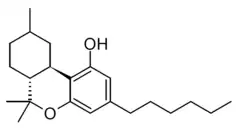Hexahydrocannabihexol
Hexahydrocannabihexol (HHCH) is a semi-synthetic cannabinoid derivative. It was first synthesised by Roger Adams in 1942 and found to be more potent than either the pentyl or heptyl homologues, or the unsaturated tetrahydrocannabinol analogue.[1][2] HHCH is classified as an "intoxicating cannabinoid" in Colorado and requires a license for its manufacture or distribution.[3]
 | |
| Identifiers | |
|---|---|
| |
| Chemical and physical data | |
| Formula | C22H34O2 |
| Molar mass | 330.512 g·mol−1 |
| 3D model (JSmol) | |
| |
References
- Adams R, Loewe S, Smith CM, McPhee WD (March 1942). "Tetrahydrocannabinol homologs and analogs with marihuana activity. XIII". Journal of the American Chemical Society. 64 (3): 694–697. doi:10.1021/ja01255a061.
- "Hexahydrocannabinol (HHC) and related substances" (PDF). European Monitoring Centre for Drugs and Drug Addiction. 2023.
- "Senate Bill 23-271" (PDF). General Assembly, State of Colorado.
This article is issued from Wikipedia. The text is licensed under Creative Commons - Attribution - Sharealike. Additional terms may apply for the media files.